BEING A MAGICIAN is apparently hard on one’s clothes. This is doubly true for necromancers. At least, if you look at my artwork, that’s the inevitable conclusion.
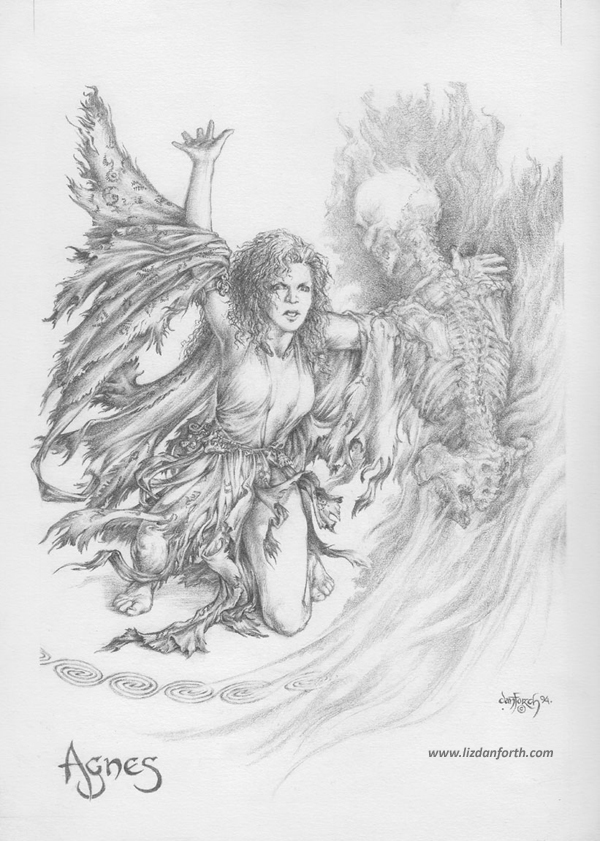
I never set out to do this consciously. Hindsight is 20/20, and it has only become evident over time. For months now, I’ve been cogitating on the whole “sex, gender, sexism, and teh hawtness” topic that I mentioned in September and again in a post last October. I’ve been mentally tagging pictures on the subject, my work and others’. That’s when I started to notice a pattern emerging about how I depicted magic and magicians.
The sex, sexism etc topic is an enormous and very complicated subject I can’t begin to do justice to in a single post. So I’m going to take smaller bites and, like this one, some posts will only address that background topic obliquely.
NAKED NECROMANCERS
I tagged a previous post with “nekkid peeples,” which elicited chortles from one commenter. (This post has that tag also. You’re not surprised, are you?) So let’s start by looking at some of the necromancers I’ve drawn or painted over the years.
Probably the piece I’m best known for in this category is The Summoner, an illustration that appeared in the back of the Fifth Edition rules for Tunnels & Trolls. I talked about this piece in a Pictures Have Stories post last September:
Then there’s the necromancer of “Never Refuse,” a piece of card art I did for the Middle Earth collectible card game. This was the first post tagged “nekkid peeples.” I was quite taken with the idea of the grievous consequences to telling an narcissistic, self-centered magician “No means NO” … in a really creepy, glad-this-is-not-literally-true way.
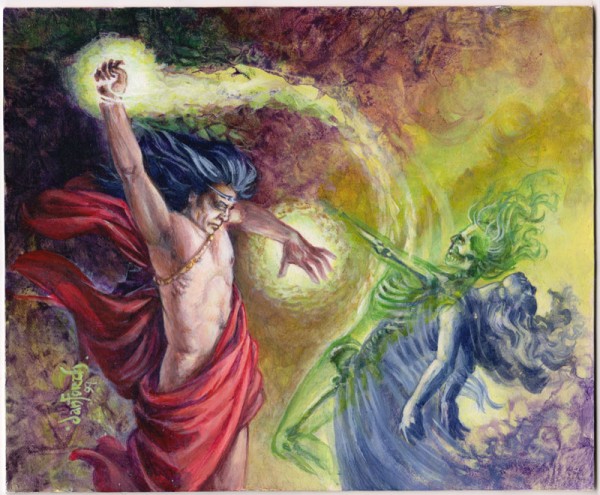
Because of the nature of this picture and the black humor jest I have made about getting “boned” one way or another, let me note that I have been sexually assaulted more than once in my life, so don’t imagine I cannot take the topic seriously. This is definitely a picture about the abuse of power.
NICER WIZARDS
But more pleasant magicians I have painted also show evidence that I think the winds of the arcane blow when spells are being cast. Consider this happy druid who, admittedly, may or may not have conjured wings onto her long-suffering cats. Whatever the magic, it is not shredding her clothes, only lifting the heavy-looking sleeves.
The picture, Freyalise Supplicant, appeared in the Magic: the Gathering card game. One of these days I will share with you this picture’s extremely long, rather poignant and interesting story.
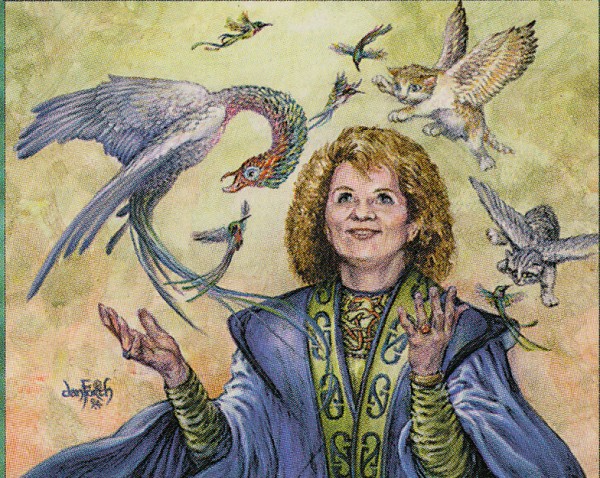
Next is another Magic card, another druid, casting a summoning. Her minimalist clothes are flying all over the place, even enwrapping the badger beastie she is conjuring up. Or maybe the furry godling was saying “For Light’s sake, woman, put on some clothes! Here, take my wrap.” With the jewelry at its throat and arm, the badger definitely started out wearing more than she is, with just those few leaves in her hair.
I’m amused to see the card text refer to “The wizard Greensleeves…” since there is no sleeve to be seen anywhere, much less a green one. That is the hazard of not telling the artist details like this!
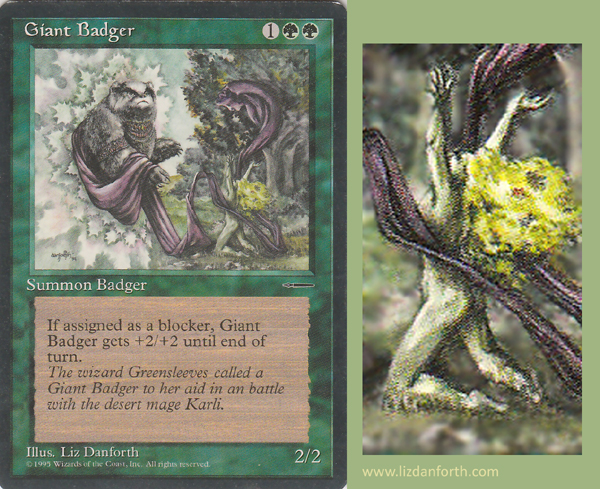
Next I’ll offer another woman in mid-cast, one of my most popular prints. Lierra, Sorceress is a piece of concept art I did for (as I dimly recall) Bard’s Tale IV when that was being developed by Electronic Arts.
Her clothes are definitely in motion, but they’re not being tattered by magical winds. One could debate whether the movement is because she is herself in motion, but regardless of that, I always felt like the skirt might trip her in another step or two… wouldn’t that be awkward? But I liked the way it looked, so I left it.
We’ll have a discussion of that keyhole top another time.
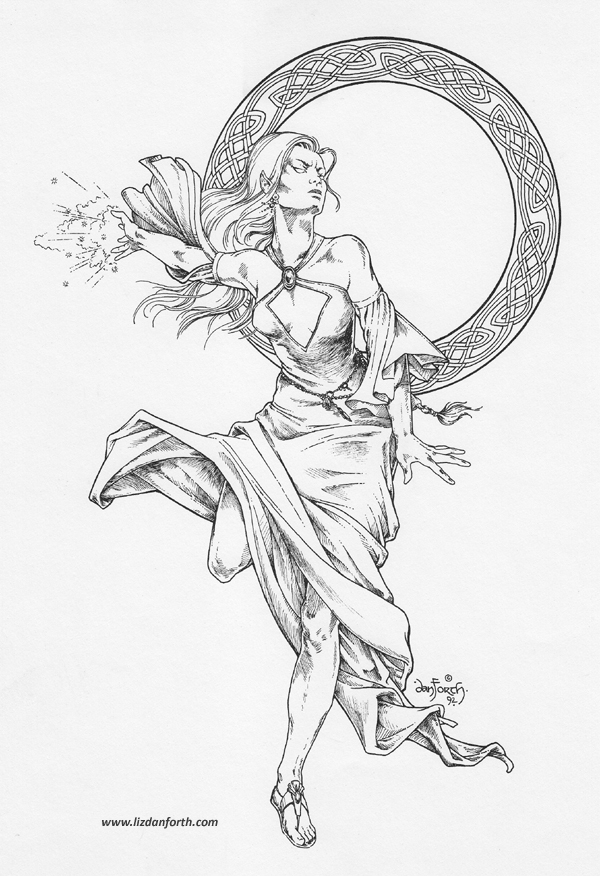
The next example for your consideration is my rather modified take on the mage I play in World of Warcraft, generalized to be included in the poster I painted for American Libraries Association several years ago to promote National Gaming Day @ Your Library.
Limitations in the game prevent clothes from much shifting about as the characters move. But for my own satisfaction creating this painting, I had to lift his hair in the magical winds, and twist the decorative panels hanging from his waist against his skirt, er, I mean his wizard robes. (What ARE those things anyway?)
But not every spell raises those energies, it seems. Below I offer a picture of another mage (but one whose resemblance to the previous one is not accidental although I always liked the look of a trimmed goatee). While reading about the casting of a new spell, this wizard doodles with the magics, testing how the parts work for later use in a full-blown incantation. If there are a few hairs out of place, it looks more like shaggy bed-head than the result of being windblown by a blast from the otherworld.
This image, colorized by Steve Crompton, usually goes by the title of “Studious Mage” and it’s one that I am entirely too pleased by. The picture was created for the French edition of Tunnels & Trolls, and both the black-and-white and the color versions appear in that book.
AN’ YER POINT IS… ?
I think there are a number of things going on in why these pictures look the way they do.
Foremost, what does magic look like? Since I’m a pretty crusty skeptic, I say “No one knows” which allows me to make it up. The conventional concept of wizards, mages and enchanters wiggling their fingers until reality is changed seems linked to the grand performances of stage magicians misdirecting our eyes.
But speaking as an artist, we face conflicting concepts when called upon to depict magical scenes. On one hand, the mages change reality with the power of their minds — that’s almost a definition of the category. But thinking at someone is just not a super-visual thing!
Additionally, wizards of lore, fairy tales, and fantasy are powerful, potent characters able to wield devastating and earth-shattering enchantments and conjurations. While explosions are certainly visual, how do you make it more personal than someone tossing a stick of dynamite or, say, shouldering a LAW rocket in the latest Hollywood blockbuster?
More to the point, how do you convey the concept of gentler or subtler magics? For me, I guess the answer involves magicians opening gates between worlds, and the air pressure is evidently not equal on each side of the portal.
As an aside: when I am writing fiction about magic, none of this occurs. It seems to be a visual thing. Weird, huh?
THE WONDERS OF CLOTH
I love to draw cloth. I cannot say I’m really great at it, but given the opportunity to draw flowing folded cloth, I rarely say no.
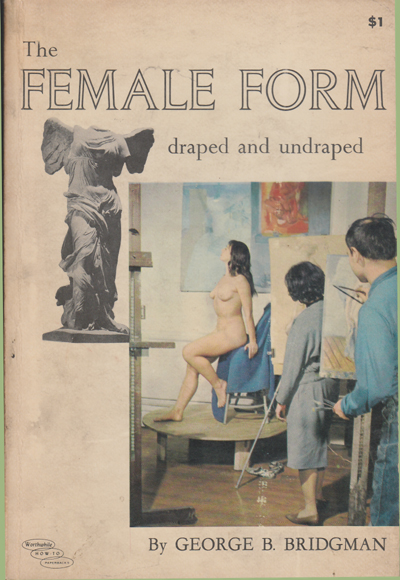 My dad collected art books in his day, and one of them was this one. Being a guy, he was probably more captured by the “female” and the “undraped” aspects of the title, but when the book made its way into my young hands, it was the “draped” that captured my attention. The statue of Nike on the cover probably had a lot to do with it. (And lo and behold, doesn’t it look like the cloth might trip the goddess too!)
My dad collected art books in his day, and one of them was this one. Being a guy, he was probably more captured by the “female” and the “undraped” aspects of the title, but when the book made its way into my young hands, it was the “draped” that captured my attention. The statue of Nike on the cover probably had a lot to do with it. (And lo and behold, doesn’t it look like the cloth might trip the goddess too!)
The book breaks down the ways large swaths of cloth typically fold and bend, and conveys a little about how to create rhythm and structure in a drawing, while conveying the shape of the body underneath. Who knew different folds had different names?
There are plenty of better books that show cloth — books of Howard Schatz’s underwater photography have some of the best — but this is the book that first taught me to see and hope to understand cloth.
GOING SKYCLAD
Because I have pagan friends, I’ve been aware since college age of the idea of magic ritual being conducted while naked or nearly so. I can’t say I’ve ever thought “I should include that in my picture” any more than I include any religious iconography into my artwork unless it is appropriate and resonant to the image I’ve been requested to create. But sometimes it seems to. I expect that is the principle under which, for example, the badger-summoning druid above is shown outdoors and unclothed — literally skyclad.
TATTERS
 The necromantic magicians I’ve done are the ones with their clothes in the worst shape. The subconscious cause is, I think, simplest of all, for all that I did not think of this until trying to analyze things after the fact.
The necromantic magicians I’ve done are the ones with their clothes in the worst shape. The subconscious cause is, I think, simplest of all, for all that I did not think of this until trying to analyze things after the fact.
The tattered clothing evokes grave cloths. Shrouds. We’ve all see cloth discarded in the gutter, or a kitchen towel accidentally buried in the dirt by the wood pile. Cloth decays rapidly, easily ripping and shredding even in the course of ordinary, everyday use. (I had to stitch up a pair of slacks earlier today, in fact.)
Add the idea that necromantic magics are universally considered the vilest and most dangerous by those who believe in such, whether across cultures in the real world or in the internal realities of fantasy tales. A magician who tinkers with such things can expect terrible results under even the best conditions.
Perhaps it is easier to intentionally wear less than go buy a new tuxedo after every girl says “No means no, mister.” And if she happens to say yes, you’re ready to go.
SEXY WIZARDS?
Turning to the question of clothing and nakedness, sexiness, sexism, and how all that relates to fantasy art — a question that has shown up time and again in blogs, Tumblrs, and recently in all three of the interviews I was asked to respond to — I’ll turn it around.
The characters in the pictures I’ve put up here range from buck naked to dressed in high collared elaborate garb. Both men and women are shown minus a stitch or two, with cloth artfully keeping them publishable. Are any of them sexually exploitative, and if so to what extent? Which of them seem sexy (if any), and why?
Tell me your thoughts. I’m interested.
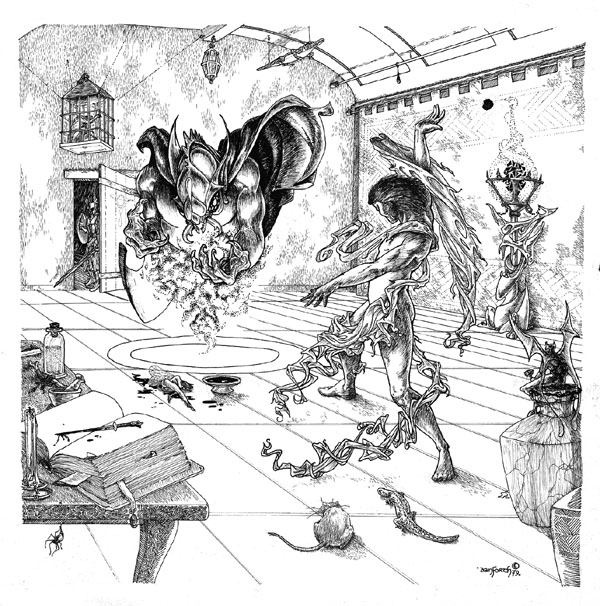
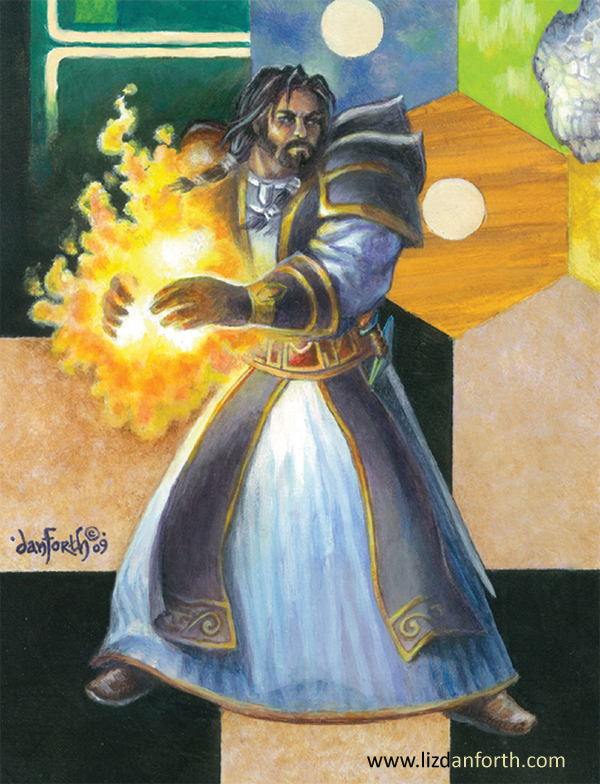
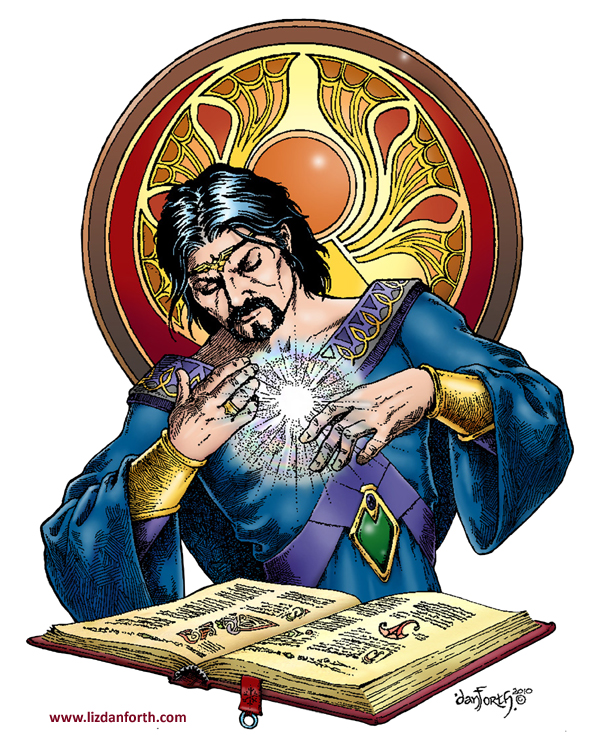
You know my call on this one — yes, very sexy. No, not at all exploitative. That’s not something very many people can pull off, and you do it, and you’ve always done it. You draw sexy people who are people first, and sexy incidentally. (And as far as I can judge, you’ve always given sexy men at *least* equal time with sexy women.)
If you’re troubled about this issue, untrouble yourself! You somehow have the magic power to get the best of both worlds, sexy yet not exploitative. And apparently without even trying hard. Be grateful! 🙂
Not so much troubled, Ed, as prone to overthink things, and mull on any subject that doesn’t lend itself to easy answers. But thank you — I hope others would agree with your opinion!
Interesting post, Liz. One other angle to consider is that clothing rarely seems to be a personal choice for a magic user. Often they’ll wear ritual garb that helps their magic, for example. I think there’s also the dichotomy between the magical and physical realms in many settings, so a magician who spends most of his/her time in the magical realms might not pay too much attention to his/her clothes. This is probably especially true of the necromancers, where they dabble in the forbidden and might be consumed with studying the dead, so they don’t always wear the latest fashions or even mended clothes.
As for the sexism angle, I think you covered it well enough. I don’t see any of the pictures as exploitative. I think the one that comes closest would be the book on the female form, especially the undraped version on the cover. 🙂 I suspect that was intended to titillate more than your art. 🙂
I really do appreciate the glimpses of the motivation behind the art. Definitely looking forward to the story on Freyalise Supplicant.
I think you’re right about the book, Brian!! There is a definitely thread of “too polite to view porn but will look at art books” through the books I inherited from my dad. He was an artist in his own right, so I don’t mean to take anything away from him in that regard. But his selection of books has a certain tenor running through them, and the cover of this book fits that paradigm.
Your art is, as always, amazing, and a significant contribution to any venue in which it is included. I can’t even draw good stick people, so I am not about to criticize your work. I always enjoy seeing it wherever I am fortunate enough to find it. You go, girl! My lycanthrope guy, Wulf the wayfarer, will be glad to come and take your side if anyone dares to insult your contributions to the genre.
Thank you, Roy. Tastes differ, and while I have certainly heard people prefer others’ work to mine, I really have no complaints about how I seem to be viewed in the genre. Quite the contrary; I am often amazed by how my contributions are received.
Wonderful post. The intersection of Power and Mind is Wizardry, but that’s not the intersection where Clothes or Fashion live. If you live in your mind, like a Silicon Valley Engineer, clothes don’t matter so much–and care for them sometimes gets in the way. If you are a hardware engineer, or even better mechanical, your clothes take a horrible beating. Because I work with acids for some of my projects, I occasionally have clothes almost disappear–and I’m knowledgeable and careful (well, relatively). (I find the results of acid etching clothing fascinating, and may intentionally make a steampunk alchemy outfit…)
Necromancers would be much more on both “Show the Power with Clothes” and “Fail to Take Care of things” scale, and would dress in robes, that would be tattered. If you have values of power over death and control of mindless beings, I doubt the conditions of your clothing matter much.
And the sort of people who control you with a gesture and a word? Yeah, clothes would be another mean to that end.
But your retrospective of this theme within your art provides the backbone (and ribs) of a full discussion. Thank yoU!
I love the acid-spotted clothes idea … and yes, I’ve had artist friends who work with chemicals and fire (welders, for example) whose clothes definitely show the evidence of their preferred mediums.
Your artwork has continued to be in my top five illustrators of all time category. You’re in good company: Barry Windsor Smith, Aubrey Beardsley, Frank Frazetta, and Alphonse Mucha! I studied art, but am an indifferent sculptor and pen and ink person. That being said, I’m also a huge fan of swords and sorcery, and your artwork has that “essence” of fantasy in the sword and sorcery genre. It stands up well as heroic or modern fantasy too!
Regarding the issue of nudity in fantasy art, I think there is almost a need for it in some ways. What I mean is that fantasy and particularly Swords and Sorcery has elements of primal and the primeval in it: Man vs. The Natural and the Supernatural. The lack of clothing is not only literal but symbolic of mankinds intrinsic strength (whether physical or supernatural) versus the overwhelming might of the known and unknown. After all clothes don’t fare too well against tigers, or trolls…. Not only that but tattered clothes give the impression of gritty strength and endurance as far as I’m concerned.
As far as how magic is depicted…. Well, I was once a practicing Wiccan and magic is not so much a visual thing as a visualized thing. The long term effects of magic are only percieved through patience and hindsight. Fantasy magic on the other hand can do whatever it bloody well pleases! It IS magic after all!
I can’t believe you put me in the company of those lights, Dwight, but thank you sincerely.
I like your take on the Man vs Nature aspect of fantasy although I’ll have to think about whether I agree it’s the key fundament to fantasy. My initial reaction is “no” but I can see where you’re coming from, despite that.
I would simply add that it is one of many things that build as a foundation for the genre. Humankind versus the supernatural/unknown is probably the oldest story people have been telling or interacting with in some form or another since we could communicate.
As an aside, I worked for college libraries during my higher education days, and I married a wonderful woman who is a library technician at the Washington State Law Library of the Supreme Court. She knew I was all right when I asked her, “So what sytem do you use? Library of Congress, or something else?” We just celebrated 12 years together last Friday.
None of this has anything to do with the comment I made in my first posting, but I thought you’d like to know a little bit more about me. I am fortunate to live in Olympia, Washington, and that we have an excellent library and inter-library loan service. I thought you might like to hear that too!
It is good to learn more about the people here — thank you for sharing! And yes… always good to hear positive libraries tales as well, indeed. 8D
Liz,
One of the things I have always admired about your art is that you draw clothed peopled very well. Whereas I don’t. There was a standard set decades ago that seemed to have all women scantily clad and buxom, and all men shirtless and with well developed abdominals (“six-pack” in today’s terms). Maybe it was Frank Frazetta, maybe John Buscema’s Conan, or Boris Vallejo. Don’t know, but it stuck. My wife often asks why I draw most of my fantasy women in the same way. And I say because I also have to draw the men in that stereotype too. “Equal time rule” I suppose. Moralists tend to only see, and be opposed to, the scantily clad buxom female and not the scatily clad ripped male. What to do?
Love you art as always.
That standard goes back to fantasy and S/F’s lurid pulp cover history, David.
And given what I come across in the blogosphere discussing this whole topic, there is some definitely complaining going on about the unrealistic ripped males too. The key difference seems to be that the women are horrifically distorted in pose and anatomy, positions no human being could attain outside Cirque de Soleil. The men may be idealized, but their poses are considerably more natural.
Cirque de Soleil? I remember 300 being described as an extended infomercial for HGH…
Looks like your wizards/sorceress’ need more than one bundle of warm dry clothing & pack
I LOVE how you draw (or paint) draped fabrics. Lots of great stuff here. I think a lot of artists draw things intuitively and then discover the reason why they drew it that way later. (i know I often do anyway. As for ankedness… well I have to confess my best work has probably been of nekked people, (specifically women) because when I draw them, I spend oh so much more time on getting them “just right”.
Right on both counts, Steve. Which also accounts for why my men are often less well-garbed than my women, I think. If you get it “just right” then why would the artist want to cover it up??
Attitudes to sex vary depending on your nature, culture, and upbringing. Personally, I feel the clue is in the word ‘fantasy’, and there’s nothing wrong with fantasy. In fact, I think fantasy, sexual or otherwise, is an important learning tool and safety valve. Drawings are not exploited people. They are drawings. If you’re coming out and saying ‘I think men (/women) are inferior and that’s why I draw them half naked’, then expect to be shot down in flames. If you’re saying, as I think you are, ‘I respect both men and women of all cultures, but I’ll draw people according to my aesthetic, fantastic, and sexual preferences, simply because I can’, then more power to your elbow! Those who oppress and exploit should be condemned, but they shouldn’t be allowed to stop the rest of us enjoying ourselves in the privacy of our own homes or in our fantasy lives. I’ll take this opportunity to say that I was first introduced to your art, Liz, in the early 80s, T&T 5th ed., in a friend’s father’s basement drinking club in Bath, England. Being 15 or so I didn’t have much money for drinking, but four friends played T&T from dusk till dawn, and Liz Danforth’s art played the major part in evoking the appropriate atmosphere. Never to be forgotten.
Thank you for the compliment, Don. I’m glad my artwork was well-received by your 15-year-old self, and I hope it continues to please.
Regarding drawings being exploitative: there I have to disagree with you. I believe they can be, the same as in any other entertainment or entertainment-associated medium whether movies, games or music. (Perhaps that isn’t your point, but rather that no real people were degraded in the making of any of my pieces up above.)
It’s a tricky word, “exploitation” that often falls under the definition of “I know it when I see it.” Sometimes an exploitative image is so blatantly so, most people of a variety of natures, cultures, and upbringing will agree. Other times, not so much.
Perhaps this is fodder for a lengthier discussion.
That is indeed my point, and so for now we’ll have to agree to disagree, but I’d welcome that lengthier discussion sometime. Much respect.